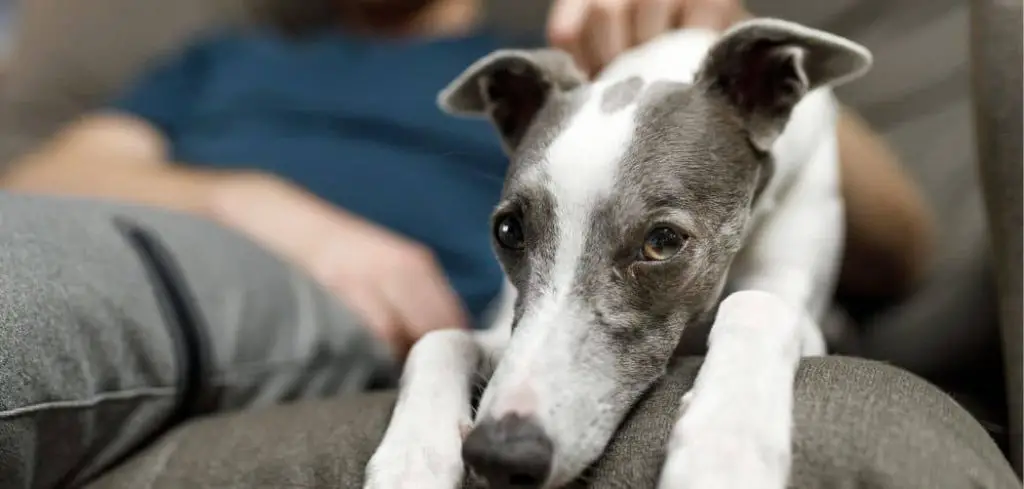Panting while laying down can worry many dog owners, especially when it seems excessive or out of the ordinary.
While panting is a normal way for dogs to cool themselves, persistent panting in a resting dog may indicate stress or discomfort.
We outline the common reasons why dogs may pant while laying down, what you can do at home, and when to seek veterinary help.
Dog Panting and Laying Down — Why It Happens
Panting while lying down may signal that your dog is overheated, in pain, or struggling with breathing difficulties. Sometimes it’s linked to heart disease, lung problems, or arthritis that makes them uncomfortable even at rest.
If your dog pants heavily while resting indoors in a cool environment, it may be a red flag that requires a veterinary checkup.

Dog Panting and Laying Down: Common Causes
Heat Stress or Overheating
Panting is a primary way dogs regulate body temperature. When a dog lays down in a warm environment, panting can become more pronounced.
Other signs include drooling, lethargy, and a flushed tongue or gums. Overheating can be dangerous and, in severe cases, lead to heatstroke.
Read more: Dog Panting and Licking a Lot (Why dogs do it and what it means)
Anxiety or Stress
Even when resting, dogs can pant due to stress or anxiety. A dog may lay down yet remain alert and panting if they feel nervous or unsettled.
Triggers can include loud noises, separation anxiety, or changes in routine. Additional signs may include pacing, whining, trembling, or avoidance behaviors.
Pain or Discomfort
Panting while laying down can indicate pain. Dogs often hide discomfort, and panting may be one of the few outward signs.
Watch for limping, reluctance to move, or sensitivity to touch. Pain may arise from arthritis, injury, gastrointestinal discomfort, or other internal conditions.
Heart or Respiratory Problems
Dogs with heart disease, congestive heart failure, or respiratory issues may pant more when resting. Laying down can increase the effort required to breathe, leading to noticeable panting.
Other signs include coughing, rapid heartbeat, fatigue, or bluish gums. Early detection is key to managing these conditions effectively.
Fever or Infection
Panting can be a response to fever or illness. Dogs may lay down more often and pant to help regulate their body temperature during an infection.
Symptoms to watch for include lethargy, reduced appetite, vomiting, or unusual behavior. Prompt veterinary care is essential to diagnose and treat underlying causes.
Obesity or Poor Fitness
Overweight or unfit dogs may pant more easily, even at rest. Laying down may not relieve the strain on their body, resulting in continued panting.
Signs include quick fatigue, difficulty walking, or reluctance to exercise. Maintaining a healthy weight and fitness level can reduce resting panting.
Read more: Dog Panting and Laying Around (Understanding resting panting)
What to Do If Your Dog Is Panting and Laying Down
Provide a cool, comfortable environment. Ensure your dog has access to shade, fresh water, and a comfortable resting area to help regulate body temperature.
Observe for patterns in panting and rest. Note whether panting occurs after activity, during stress, or persistently while laying down.
Encourage gentle exercise and monitor weight. Proper activity can help improve cardiovascular health and reduce panting associated with obesity or poor fitness.
Check for signs of pain or discomfort. If your dog is sensitive to touch or seems restless, consult your veterinarian for a thorough examination.
Seek medical advice if panting persists. Persistent panting at rest can indicate underlying health problems that need diagnosis and treatment by a veterinarian.
When to Call or Visit Your Vet
Seek immediate veterinary attention if your dog exhibits:
Excessive panting while resting, especially if accompanied by drooling or vomiting
Signs of pain, discomfort, or reluctance to move
Coughing, rapid heartbeat, or labored breathing
Lethargy, weakness, or collapse
Fever, unusual behavior, or sudden onset of panting
Prompt veterinary care can help prevent complications and ensure your dog’s health and comfort.
Read more: Dog panting excessively (Here’s Why)
Key Takeaway
Panting while laying down can be a normal cooling mechanism or a sign of stress, pain, or underlying medical conditions.
Careful observation, providing a comfortable environment, and consulting a veterinarian when necessary are crucial steps.
By addressing these signs early, you can help your dog stay healthy, comfortable, and happy.
